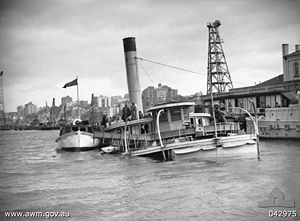HMAS Kuttabul (ship)
 Kuttabul after sinking. | |
| Career (Australia (Sydney Ferries, RAN)) | |
|---|---|
| Name: | Kuttabul |
| Namesake: | Aboriginal word meaning "wonderful" |
| Builder: | Newcastle State Dockyard |
| In service: | 1922 |
| Fate: | sunk |
| General characteristics | |
| Type: | Harbour ferry |
| Displacement: |
448 gross tonnes 201 net tonnes |
| Length: | 183 feet (56 m) |
| Beam: | 36 metres (118 ft) |
| Capacity: | 2,250 passengers as ferry |
HMAS Kuttabul was a Royal Australian Navy (RAN) depot ship, and former Sydney harbour ferry. During the Japanese midget submarine attack on Sydney Harbour on 31 May 1942, Kuttabul was torpedoed and sunk, with 21 Commonwealth naval personnel aboard.
Design and construction
Kuttabul originated as a steam-powered ferry, built in 1922 by the Newcastle State Dockyard in Newcastle, New South Wales. Kuttabul was rated at 448 gross and 201 net tonnes (1269 and 569 m³), was 183 feet (56 m) long, with a beam of 36 metres (118 ft), capable of seating approximately 2,250 passengers. Kuttabul and near sister ship Koompartoo were the largest ferries ever operated on the inner harbour ferry routes, however Koompartoo could hold slightly more passengers. Kuttabul was built with a wooden hull, contrasting with the steel hulled Koompartoo. Both boats had wooden superstructures
Operational history
Sydney Ferries
Kuttabul spent most of its life as a double-ended Sydney suburban ferry, carrying passengers across Sydney Harbour, linking the downtown ferry terminal at Circular Quay with various suburban ferry wharves, but especially the heavy route between the Quay and Milsons Point.
Made redundant by the opening of the Sydney Harbour Bridge in 1932, Kuttabul was laid up, along with its sister ship, Koompartoo,[1] both of which were later made available for tourist cruises on Sydney Harbour.[2]
RAN
After the outbreak of World War II, Kuttabul was requisitioned by the RAN, and moored at the Garden Island naval base to provide accommodation for Allied naval personnel whle they awaited transfer to their ships.[1]
On the night of 31 May-1 June 1942, three Ko-hyoteki class midget submarines of the Imperial Japanese Navy entered Sydney Harbour with the intention of attacking Allied warships. Only one of the submarines, designated M-24, was able to fire her torpedoes, but both torpedoes missed their intendeded target: the heavy cruiser USS Chicago.[1] The torpedoes continued on to Garden Island: one running aground harmlessly, the other struck the seawall, against which Kuttabul was moored, and detonated.[1] The ferry suffered extensive damage and sank, killing 21 of the sailors sleeping onboard.[1]
One of the wheelhouses was salvaged and used as a naval police guardhouse, which was renamed HMAS Kuttabul in memory of the ship and those killed. The wheelhouse is currently exhibited at the Australian War Memorial, alongside a composite Japanese submarine built from the wreckage of two of the attackers.
References
- ^ Sydney Heritage Fleet. List of Ships and Other Vessels F to K. Retrieved 28 November 2005.
| ||||||||||||||||||||||||||||||||||||||
| 40px | This article about a specific Australian naval ship or boat is a stub. You can help Ship Spotting World by expanding it. |
